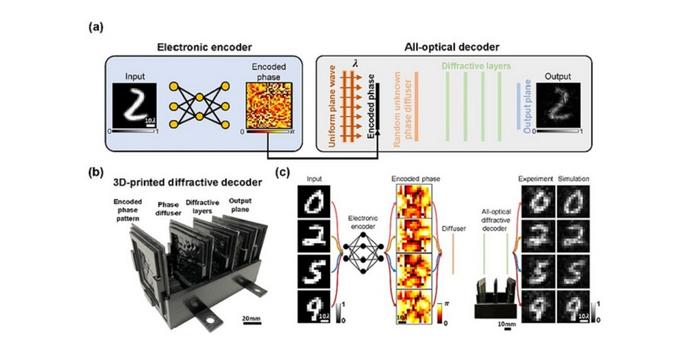Transferring optical information in free space with large bandwidth and high transmission capacity has gained significant attention in various applications, such as remote sensing, underwater communication, and medical devices. Nevertheless, unpredictable, unknown phase perturbations or random diffusers within the optical path pose great challenges, limiting the high-fidelity transmission of optical data in free space. Adaptive optics presents a potential solution that can correct for random distortions dynamically; however, spatial light modulators and iterative feedback algorithms employed inevitably increase both cost and complexity.

Credit: Li et al., doi 10.1117/1.AP.5.4.046009.
Transferring optical information in free space with large bandwidth and high transmission capacity has gained significant attention in various applications, such as remote sensing, underwater communication, and medical devices. Nevertheless, unpredictable, unknown phase perturbations or random diffusers within the optical path pose great challenges, limiting the high-fidelity transmission of optical data in free space. Adaptive optics presents a potential solution that can correct for random distortions dynamically; however, spatial light modulators and iterative feedback algorithms employed inevitably increase both cost and complexity.
A team of researchers led by Professor Aydogan Ozcan from the Electrical and Computer Engineering Department at University of California, Los Angeles (UCLA), introduced a new solution recently published in Advanced Photonics. This new approach uses electronic encoding and diffractive optical decoding to transmit optical information through random, unknown diffusers with high fidelity. Trained through supervised learning, this hybrid model incorporates a convolutional neural network (CNN)-based electronic encoder along with co-optimized transmissive passive diffractive layers that are physically fabricated. After this one-time joint training process, the resulting hybrid model can accurately transfer optical information of interest even in the presence of unknown phase diffusers, successfully generalizing to pass information through unseen random diffusers. This new approach significantly outperforms systems that only utilize either a diffractive optical network or an electronic neural network for optical information transfer through diffusive random media, highlighting the importance of having both an electronic encoder and a diffractive decoder that work together.
The experimental proof of concept and the feasibility of this hybrid electronic-optical model were validated using a 3D-printed diffractive network operating in the terahertz part of the electromagnetic spectrum. The optical decoder of the hybrid model can be physically scaled—either expanded or shrunk—to operate across different parts of the electromagnetic spectrum, eliminating the need for retraining its diffractive features.
The UCLA research team believes this framework would provide a low-power and compact alternative for various applications, such as the transmission of biomedical sensing and imaging data in implantable systems, underwater optical communication, and data transmission through turbulent atmospheric conditions.
For the details of this advance, read the Gold Open Access article by Li et al., “Optical information transfer through random unknown diffusers using electronic encoding and diffractive decoding,” Adv. Photon. 4(4) 046009 (2023), doi 10.1117/1.AP.5.4.046009.
Journal
Advanced Photonics
DOI
10.1117/1.AP.5.4.046009
Article Title
Optical information transfer through random unknown diffusers using electronic encoding and diffractive decoding
Article Publication Date
28-Aug-2023




